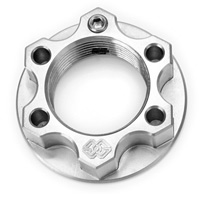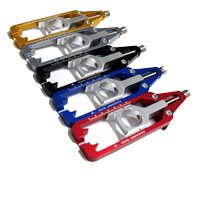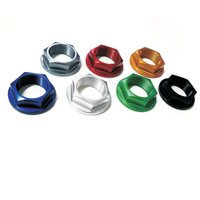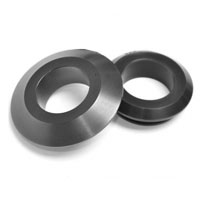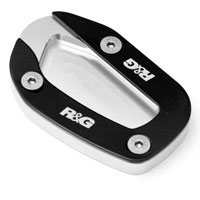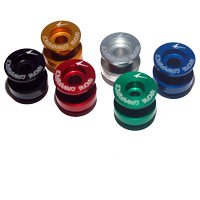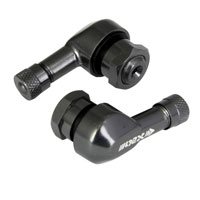Motorcycle chassis - motorcycle add-on parts for chassis & frame
Motorcycle chassis
Safe and fast on the road with a well adjusted motorcycle chassis
Besides your driving skills, the chassis decides how fast you can negotiate curves. In our online shop you will find many add-on parts for your motorcycle to optimize the chassis. The selection ranges from axle nuts, the chain tensioner, the steering head nut, wheel distances to the stand mount and the side stand plate.
More safety and comfort on the bike
The first motorcycle generations suitable for series production had a rigid frame. Modern and high-quality suspension elements have long been part of the motorcycle chassis. They offer various adjustment possibilities and thus allow individual adjustment to the rider.
But why should/must the chassis be adjusted? This is not necessary for cars. Compared to a car, the motorcycle reacts much more sensitively and seriously to changes in the load. This influences the vehicle geometry and the driving behaviour. The biggest part of the vehicle weight, of the carried luggage and of course of the driver and passenger is carried by the swinging wound wire structures. Only when the entire chassis with all its individual components are correctly adjusted to each other can it develop its full performance capability.
The suspension - the beginning of chassis optimization
To adjust the motorcycle chassis, you have to adjust the level first. When you take the bike off the stand, it will sag into the springs. The same applies when the crew is seated and the luggage is loaded. The springs are already compressed a little by this and the weight of the machine. It stands on the springs and can level off at a certain height above the road surface. The English-speaking world refers to this as "ride height". Translated it means as much as ride height.
This means that a certain amount of the total suspension travel is already used up. This "distance" is called negative suspension travel. The remaining spring travel available up to the stop is called positive spring travel. The ratio between positive and negative travel should be about one to two thirds. This makes it clear: The adjustment of the spring elements must always be carried out depending on the load. It doesn't matter whether you take a pillion passenger with you or turn your bike into a load mule for luggage.
Front suspension adjustment
The spring stiffness of the fork and suspension strut (monoshock) must be suitable for the rider's weight, your riding style and the intended use, for example racing, touring or motorcross. The inside of the fork is filled with oil. It is responsible for the damping and also influences the spring work. Below the upper fork plug there is an air cushion. It is compressed during compression and hardens progressively as the motorcycle fork is increasingly immersed. Springs that are too hard can be softened by enlarging the air cushion (drain some oil). However, this should not compensate for more than 5 to 10 percent of the spring hardness. Conversely, if the suspension is too soft, this method also works by increasing the oil volume. Here you should note that the smaller air cushion during compression builds up a higher overpressure inside the fork, the fork can leak.
This is how you get the motorcycle shock absorber on trot - adjusting the preload
Nearly all motorcycles offer you the possibility to adjust at least the rear shock absorber with an adjustable spring preload. This does not change the hardness of the spring, you just adjust the preload of the spring to your needs. The motorcycle will be raised or lowered.
If your bike reminds you more of a vibrating plate than a motorcycle during acceleration, and the handling in curves leaves a lot to be desired, this could be due to badly adjusted shock absorbers, too much compression and too little rebound.
Rear shock absorbers offer a damping effect just like the Monoshock in front. They regulate the extension and compression movements. Mostly it works hydraulically in the forks, i.e. with oil. If the machine had no dampers, it would perform jumps that would make even a kangaroo green with envy. Once again briefly summarized: The compression stage dampens the compression movement, the rebound stage takes over the rebound.
The variety of species for chassis adjustment
The shock absorber market offers the right choice for every purse and demand. In our shop you will find suitable models for touring, motocross or racing. The classic shock absorber is very simple in construction and has no adjustment possibilities for the damping. The accessory market also offers monoshock versions with rebound adjustment. In the upper class, motorcycles usually have dampers with adjustment possibilities for the compression and rebound stages.
From the axle nut to the valve -
High quality accessories for racing, tuning and customizing
Once you have adjusted the chassis of your motorcycle to your needs, you can give it an individual look with the attachments and accessories from our shop. If you want to park the bike on softer surfaces, a Puk side stand is practical. It enlarges the supporting surface by up to 100%. The stand adapter with and without fall protection makes it easy for you to jack up to a mounting stand. You can set great accents with a colored steering head nut. The range also includes chain tensioners and valve caps.
Motorcycle chassis - motorcycle add-on parts for chassis & frame Motorcycle chassis Safe and fast on the road with a well adjusted motorcycle chassis Besides your driving skills, the...
read more » Close window Motorcycle chassis - motorcycle add-on parts for chassis & frame
Motorcycle chassis
Safe and fast on the road with a well adjusted motorcycle chassis
Besides your driving skills, the chassis decides how fast you can negotiate curves. In our online shop you will find many add-on parts for your motorcycle to optimize the chassis. The selection ranges from axle nuts, the chain tensioner, the steering head nut, wheel distances to the stand mount and the side stand plate.
More safety and comfort on the bike
The first motorcycle generations suitable for series production had a rigid frame. Modern and high-quality suspension elements have long been part of the motorcycle chassis. They offer various adjustment possibilities and thus allow individual adjustment to the rider.
But why should/must the chassis be adjusted? This is not necessary for cars. Compared to a car, the motorcycle reacts much more sensitively and seriously to changes in the load. This influences the vehicle geometry and the driving behaviour. The biggest part of the vehicle weight, of the carried luggage and of course of the driver and passenger is carried by the swinging wound wire structures. Only when the entire chassis with all its individual components are correctly adjusted to each other can it develop its full performance capability.
The suspension - the beginning of chassis optimization
To adjust the motorcycle chassis, you have to adjust the level first. When you take the bike off the stand, it will sag into the springs. The same applies when the crew is seated and the luggage is loaded. The springs are already compressed a little by this and the weight of the machine. It stands on the springs and can level off at a certain height above the road surface. The English-speaking world refers to this as "ride height". Translated it means as much as ride height.
This means that a certain amount of the total suspension travel is already used up. This "distance" is called negative suspension travel. The remaining spring travel available up to the stop is called positive spring travel. The ratio between positive and negative travel should be about one to two thirds. This makes it clear: The adjustment of the spring elements must always be carried out depending on the load. It doesn't matter whether you take a pillion passenger with you or turn your bike into a load mule for luggage.
Front suspension adjustment
The spring stiffness of the fork and suspension strut (monoshock) must be suitable for the rider's weight, your riding style and the intended use, for example racing, touring or motorcross. The inside of the fork is filled with oil. It is responsible for the damping and also influences the spring work. Below the upper fork plug there is an air cushion. It is compressed during compression and hardens progressively as the motorcycle fork is increasingly immersed. Springs that are too hard can be softened by enlarging the air cushion (drain some oil). However, this should not compensate for more than 5 to 10 percent of the spring hardness. Conversely, if the suspension is too soft, this method also works by increasing the oil volume. Here you should note that the smaller air cushion during compression builds up a higher overpressure inside the fork, the fork can leak.
This is how you get the motorcycle shock absorber on trot - adjusting the preload
Nearly all motorcycles offer you the possibility to adjust at least the rear shock absorber with an adjustable spring preload. This does not change the hardness of the spring, you just adjust the preload of the spring to your needs. The motorcycle will be raised or lowered.
If your bike reminds you more of a vibrating plate than a motorcycle during acceleration, and the handling in curves leaves a lot to be desired, this could be due to badly adjusted shock absorbers, too much compression and too little rebound.
Rear shock absorbers offer a damping effect just like the Monoshock in front. They regulate the extension and compression movements. Mostly it works hydraulically in the forks, i.e. with oil. If the machine had no dampers, it would perform jumps that would make even a kangaroo green with envy. Once again briefly summarized: The compression stage dampens the compression movement, the rebound stage takes over the rebound.
The variety of species for chassis adjustment
The shock absorber market offers the right choice for every purse and demand. In our shop you will find suitable models for touring, motocross or racing. The classic shock absorber is very simple in construction and has no adjustment possibilities for the damping. The accessory market also offers monoshock versions with rebound adjustment. In the upper class, motorcycles usually have dampers with adjustment possibilities for the compression and rebound stages.
From the axle nut to the valve -
High quality accessories for racing, tuning and customizing
Once you have adjusted the chassis of your motorcycle to your needs, you can give it an individual look with the attachments and accessories from our shop. If you want to park the bike on softer surfaces, a Puk side stand is practical. It enlarges the supporting surface by up to 100%. The stand adapter with and without fall protection makes it easy for you to jack up to a mounting stand. You can set great accents with a colored steering head nut. The range also includes chain tensioners and valve caps.

